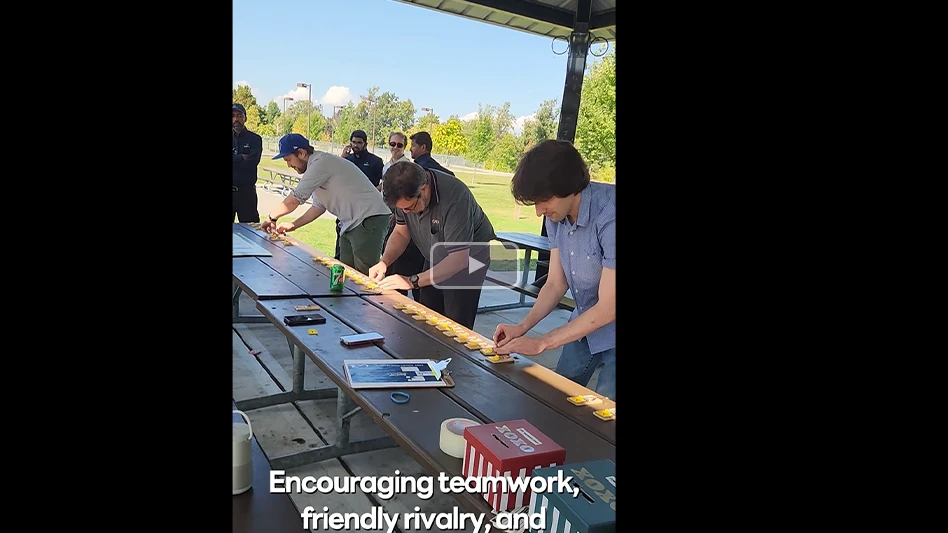We all know subterranean termites are capable of causing immense damage to structural wood. One only has to take a close look at their strong saw, blade-like mandibles to realize they are adept at chewing through wood. However, the remainder of the termite body is far from intimidating as it is soft and lightly sclerotized. Unfortunately for termites, their soft bodies are not efficient at retaining moisture; termites quickly succumb to desiccation when exposed to the elements. In order to survive, termites require a constant supply of water.
Termites typically acquire water from the soil, but the urban environment may also provide sources of moisture, such as from leaking pipes, condensation on pipes, clogged gutters, etc. It is these moisture-prone areas that are understood to be conducive to termites. During home inspections it has become commonly accepted to interpret any area with a moisture level of 20 percent or greater as an indicator of potential termite activity. The authors of this article are strong advocates of using a moisture meter during termite inspections. Hence, we set out to investigate the scientific basis underlying high moisture levels and associated termite activity.
Previous Research. Not only do termites have a preference for high moisture, but it is a critical factor in their survival. Previous research by Delaplane and La Fage (1989) has demonstrated that termite feeding behavior is influenced by the moisture content of a food substrate. In choice-feeding tests, groups of Formosan subterranean termites (Coptotermes formosanus) preferentially fed on wood blocks with the highest initial moisture content (about 96 percent). As termites consumed these high-moisture wood blocks, wood moisture decreased, which greatly contrasted with the lower moisture wood blocks (about 14 percent) where food removal was accompanied by wood moisture gain. These researchers proposed that this was indirect evidence that termites perhaps were actively relocating water. However, they cautioned that it was uncertain whether moisture gain in the low moisture wood blocks was due to equilibration of relative humidity or a termite-mediated event.
Hence, the objective of this Ohio State University study was to determine if the eastern subterranean termite (EST), Reticulitermes flavipes, can relocate water to a dry food source and, if so, what is the resultant water content of that food source. We predicted that termites would acclimate their food source to a moisture level of approximately 20 percent, which often is an indicator of termite activity during home inspections (personal observation).
Water Content/Dry Food Source. To assess the moisture change of a food item in the presence of the EST, termite workers were placed in a plastic chamber containing moist sand which was connected via Tygon tubing to a smaller Petri dish that held a dry food source (a preweighed oven-dried cellulose disc). Based on changes in weight of the cellulose disc, consumption and moisture content of the food source were evaluated over a 21-day period. A control was established without termites to assess background change in moisture of the cellulose disc due to water absorption from the environment.
Results. Termites readily consumed the cellulose discs, and water content of these discs was significantly higher in the presence of termites when compared to the control. In fact, as consumption levels increased, so did the moisture level of the cellulose discs. In the controls, the moisture level of the cellulose discs never reached above 10 percent during the entire study. However, the moisture level of the food source in the presence of termites increased throughout the study. Within 36 hours the moisture level was an average of 23 percent, which was significantly higher than the control, which was about 6 percent. The moisture level was the highest at 46 percent on day 21; however, moisture levels possibly could have increased even more if our study had continued beyond a 21-day period.
Water Sacs. While the results of the study do show that termites enhance the moisture content of their food, another important question is, "How are termites transferring water to their food?" Well, it turns out that termites possess a pair of salivary reservoirs that are closely associated with the salivary glands. The salivary reservoirs are also known as "water sacs" (Hewitt et al. 1971) and are thought to function for water storage. Water sacs are thin, translucent, ellipsoid-shaped structures that typically reside on either side of the crop, but also can extend into the abdomen. Water sacs are found within all the caste members in a termite colony. Grube and Rudolph (1999) demonstrated that the European subterranean termite, Reticulitermes santonensis, was able to use water stored in water sacs to moisten building material and raise the humidity in unfavorable microclimates. They observed that the average moisture content of sand clod samples initially was about 5.1 percent, but increased to about 44.6 percent after termites added water.
In order to assess if the termites in this study were using their water sacs to increase the moisture level of food, a number of termites were sacrificed from both the moist sand and food source periodically throughout the study. Termites were dissected and the volumes of the water sacs were determined.
*****
Gallagher One of Bayer’s ‘Young Scientists of the Year’
This article’s author, Nicola Gallagher, was a finalist in the third Bayer Environmental Science "Young Scientist of the Year" contest. The contest is a scholarship and grant program for graduate students to acknowledge and financially support exceptional research that advances the pest management industry. She received a $1,000 scholarship from Bayer, which also donated $1,000 to Ohio States’s general scholarship fund.
The winners were announced at NPMA PestWorld 2008. The contest was sponsored by Bayer and the National Pest Management Association. A panel of university and industry professionals determined the final awards.
*****
Results. In our study, EST workers sampled from the food source had smaller water sacs compared to those from the moist sand, thereby indicating that termites were releasing the reservoirs’ contents onto their food. This was especially evident during the first 36 hours of investigation as the termites’ water sacs were always smaller in those termites removed from the food arena as compared to the moist sand arena of the test apparatus. Water sacs were at their largest, approximately 0.7 ul, for termites removed at 18 hours from the moist sand arena, whereas the smallest volume was approximately 0.1 ul for termites removed at 9 hours from the food arena. This difference in volume became less notable after 36 hours, and regardless if the termites were removed from the moist sand or the food source, the average volume of the water sacs was approximately 0.3 ul. This suggests that termites may not always fill their water sacs to capacity or release all contents onto a food resource once a food resource reaches a certain moisture level, which we observed to be about 20 percent. There may be an advantage to having water reserves for other colony functions such as communication or digestion.
A single termite typically will deposit less than 1 ul of water, which may seem far too small to make an impact, but if all termites in a colony deposited that amount it would not take long for the moisture to add up. Strength in numbers is certainly true for termites.
Moisture Meters and Termite Management. This research demonstrates that termites can relocate free water to dry resources, as previously postulated by Delaplane and La Fage (1989). Furthermore, areas of more than or equal to 20 percent moisture are strong indicators of termite activity, and we recommend PMPs use moisture meters during termite inspections. Inspectors should not focus strictly on moisture-prone areas (though they definitely are very important), as our study clearly demonstrates that termites can relocate water to dry areas.
We have found a moisture meter is a very useful tool for deciding optimal placement of aboveground bait stations. A moisture meter also can be a useful monitoring tool during follow-up inspections after at termite treatment. Assessing moisture level changes (or lack thereof) pre- and post-treatment can be useful in determining whether or not further investigation is warranted.
The authors also have observed homeowners take note when a moisture meter is used during an inspection. Homeowners are more likely to pay attention when a moisture meter broadcasts a warning sound due to high moisture. This is a warning sound that homeowners do not take lightly, and they therefore are more willing to cooperate in remedying moisture issues. This is also an opportunity to educate homeowners on the importance of reducing moisture and cellulose sources around their home. Anytime a homeowner rapidly fixes a moisture problem it makes termite management more efficient.
Moisture is a critical factor in termite biology; therefore detecting and reducing water sources are key steps in a successful pest management program. So, be sure to add that moisture meter to your inspection kit. A thorough, detailed inspection leads to a prepared plan of action.
Authors’ note: The results of this research study were originally published in the 2010 issue of Sociobiology Vol. 55, No.3. The authors thank David Shetlar and Megan Meuti for their assistance. This project was supported in part by state and federal funds appropriated to the Ohio Agricultural Research and Development Center.
References
Delaplane, K. S., and J. P. La Fage. 1989. Preference for moist wood by the Formosan subterranean termite (Isoptera: Rhinotermitidae). Journal of Economic Entomology 82: 95-100.
Grube, S., and D. Rudolph. 1999. Water supply during building activities in the subterranean termite Reticulitermes santonensis De Feytaud (Isoptera, Rhinotermitidae). Insectes Sociaux 46: 192-193.
Hewitt, P. H., J.J.C. Nel, and I. Schoeman. 1971. Influence of group size on water imbibition by Hodotermes mossambicus alate termites. Journal of Insect Physiology 17: 587-600.
Nicola Gallagher is a graduate student in the department of entomology, Ohio State University, where she studies the physiological and behavioral mechanisms involved with water maintenance in subterranean termites. She can be reached at ngallagher@giemedia.com. Susan C. Jones is an associate professor of entomology at Ohio State University where her urban entomology program focuses on termites and bed bugs. E-mail her at sjones@giemedia.com.

Explore the March 2010 Issue
Check out more from this issue and find your next story to read.
Latest from Pest Control Technology
- Mosquito Squad Announces Rebranding to Mosquito Squad Plus
- Pest Control Equipment: If it’s Critical, Back it Up!
- In Memoriam: Marybeth Wonson
- In Memoriam: Layton Word
- Mitchell Boston's Involvement as Local Councilman Sparks Growth in Pest Control Business
- Grizz Pest Management Owners Support Wildlife Conservation with Brookfield Zoo in Chicago
- Grizz Pest Management Partners with Brookfield Zoo to Build Tropical Forests Exhibit
- Truly Nolen Promotes Bohne to Vice President of Business Development





